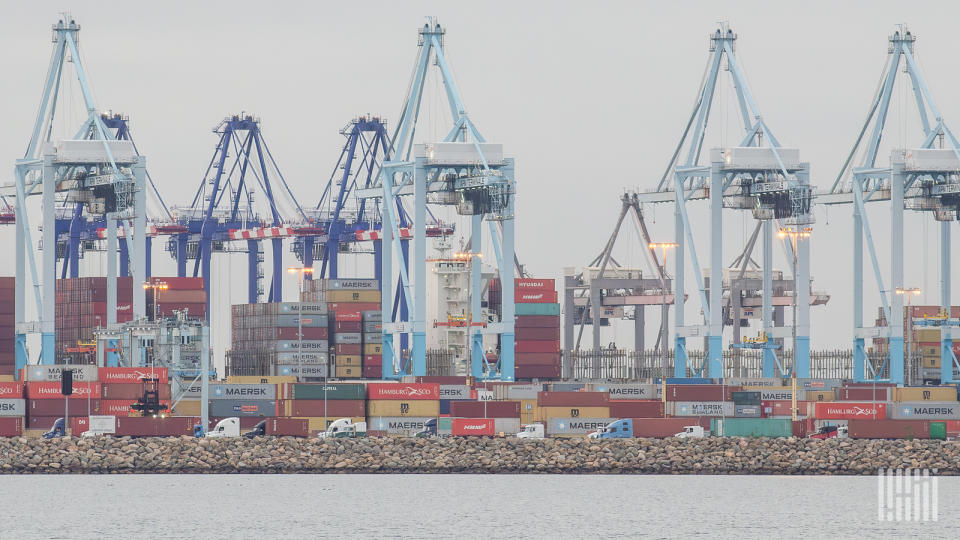Congested ports choking the supply chain

The views expressed here are solely those of the author and do not necessarily represent the views of FreightWaves or its affiliates.
The bustling ports of Los Angeles and Long Beach, California, gateways to the American consumer market, have become notorious for chronic congestion. But in January 2024, the logjam will reach a new level, threatening to send ripples through the entire U.S. economy.
This month’s ITS Logistics U.S. Port/Rail Ramp Freight Index reveals a jump in trans-Pacific volumes amid restocking for Lunar New Year, a major holiday for many East Asian countries. This is likely to collide with expected congestion at East Coast ports in the U.S. Rerouted lanes from Asia to the U.S. East Coast will see additional cost and transit-time pressure that will continue to push volumes to trans-Pacific trade lanes.
The current Lunar New Year restock is paired with diverted volumes that are a direct result of shippers’ efforts to avoid the crisis in and around the Suez Canal. As a result, underutilized West Coast ports are expected to become stressed, especially in the Los Angeles and Long Beach terminals.
Several factors on a global scale converged to create this perfect storm of congestion, the first being Lunar New Year, Feb. 10-24. It creates a confluence of the festive season plus restocking for the year ahead in China, which leads to a massive influx of containers. During the Lunar New Year celebrations, almost all factories and manufacturers in China halt their processes, ports limit their operations, and workers are unavailable, disrupting the entire supply chain and logistical operations.
Ongoing difficulties in attracting and retaining dockworkers further hampers the pace of unloading and container handling. Limited yard space and outdated technology slow the movement of goods, and disruptions in other global ports due to events like the ongoing war in Ukraine are adding to the pressure on West Coast infrastructure.
The consequences of this congestion are impacting businesses and consumers alike. Delayed shipments can lead to empty shelves and shortages of various goods, from electronics to furniture to household essentials. This can hurt businesses’ sales and frustrate consumers facing limited choices. Increased shipping costs and delays trickle down to consumers in the form of higher prices on store shelves.
Additional costs incurred by businesses due to disruptions can also impact long-term profitability. The overall slowdown in the movement of goods can have a negative impact on the U.S. economy, potentially affecting gross domestic product growth and employment rates.
Businesses and consumers alike need to brace themselves for the challenges ahead. But as in many other challenges, technology can play a key role.
Investing in real-time tracking tools and building strong relationships with logistics providers can give businesses greater control over inventory and the ability to proactively manage delays. Companies should leverage their visibility and traceability data for better inventory management. They should analyze past customer behaviors and historical order patterns during the Lunar New Year season. It will help to better guide inventory planning, anticipate demand and ensure extra inventory to cater to your customers in case of shipping delays. Relying on a wider range of suppliers and exploring alternative shipping routes can mitigate the impact of disruptions at any single port or geographic region. Modeling and simulation tools based on real-time data can help improve the network, resulting in less disruption.
The current situation at the West Coast ports — and many other ports for that matter — serves as a stark reminder of the fragility of global supply chains and the interconnectedness of the global economy. By recognizing the challenges, adapting strategies and investing in long-term technology solutions, businesses and consumers can navigate the choppy waters ahead and ensure a more resilient and efficient flow of goods in the future.
Look for more articles from me every week on FreightWaves.com.
About the author

Bart De Muynck is an industry thought leader with over 30 years of supply chain and logistics experience. He has worked for major international companies, including EY, GE Capital, Penske Logistics and PepsiCo, as well as several tech companies. He also spent eight years as a vice president of research at Gartner and, most recently, served as chief industry officer at project44. He is a member of the Forbes Technology Council and CSCMP’s Executive Inner Circle.
The post Congested ports choking the supply chain appeared first on FreightWaves.
